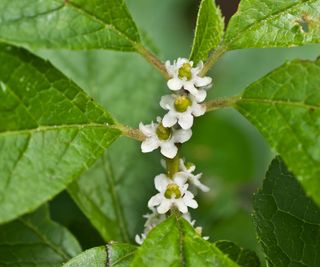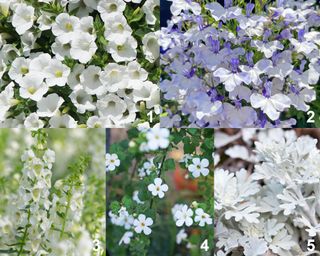Growing a pollinator garden has many benefits, not least because pollinators help us grow food. A garden with flowering shrubs for pollinators is also a beautiful space filled with native plants that support all kinds of local wildlife. It’s an easy, environmentally friendly and sustainable way to garden. These six native flowering shrubs for pollinators will boost your yard’s appeal to bees and butterflies, while filling your quiet corners with sublime flora and fragrance.
Choosing Native Flowering Shrubs for Pollinators
Pollinator-friendly native flowering shrubs are a must in a garden designed to attract beneficial bees, flies, butterflies and other pollinators. For anyone keen on gardening with native plants, the good news is that there are several options that are easy to grow. Check with your local extension office for advice on the best pollinator shrubs for your particular area. But here are some examples of stunning shrubs for pollinators which grow natively in North America.
1. Winterberry
(Image credit: Gerry Bishop / Alamy)
Winterberry (Ilex verticillata) is a deciduous native holly. Its inconspicuous flowers attract butterflies, bees and other small pollinators. Winterberry holly also feeds birds. It is native to most of the eastern United States and Canada. Winterberry is one of the most cold-hardy native pollinator shrubs and can grow as far north as zone 3.
Get male and female winterberry shrubs so the pollinators can help you enjoy the attractive red-orange berries this plant is known for. Grow winterberry in a location with full sun or partial shade as well as acidic, moist soil.
2. Serviceberry
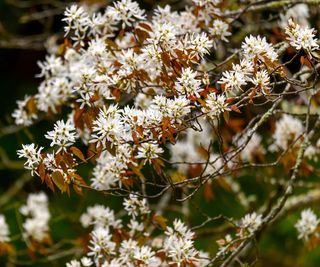
(Image credit: James W Thompson / Shutterstock)
You can grow this pollinator-friendly eastern US native as a large shrub or small, multi-stemmed tree, depending on how you trim it. For the gardener, growing serviceberry (Amelanchier spp.) provides spring flowers, purple fruit and fall foliage. Pollinators love the small flowers, while birds feed on the berries. The berries are also edible for people.
Although it can grow as tall as 25 feet (7.5m), pruning can keep a serviceberry to a more manageable size. Grow serviceberry in USDA zones 4-7 in slightly acidic, well-drained soil and a spot with full sun.
3. Summersweet
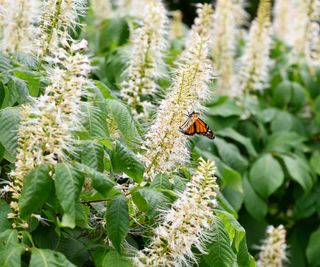
(Image credit: Lana B / Shutterstock)
The name ‘summersweet’ describes the aroma of this flowering shrub which attracts many pollinators. Also known as sweet pepperbush (Clethra alnifolia), the flowers bloom in late summer, providing a more continuous source of nectar when paired with spring and early summer flowers. The small flowers grow in clusters on long racemes. The shrub can grow up to eight feet tall and six feet (1.8-2.5m) wide.
Grow this eastern and southern native in USDA zones 3-9. The summersweet plant likes full sun or partial shade, and slightly acidic soil. This is one of the best native pollinator bushes to choose if you want a shrub that tolerates urban conditions and grows well as a hedge or border.
4. Apache Plume
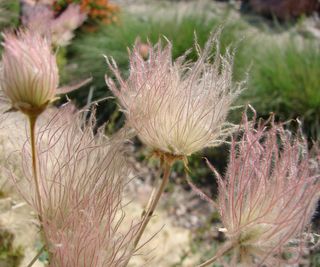
(Image credit: Kathryn Roach / Shutterstock)
Apache plume (Fallugia paradoxa) is a showy flowering shrub native to the southwestern United States. It is semi-evergreen and grows up to six feet (1.8m) tall. The white flowers attract pollinators before transforming into large, fluffy seedheads that give the plant its name.
As well as being one of the best native shrubs for pollinators, this plant is truly stunning. Thanks to its drought-tolerant nature, it will also work well in xeriscaping gardens. You can grow Apache plume in its native range and in USDA zones 4-9. It needs a location with full sun and can tolerate dry soil.
5. Rubber Rabbitbrush
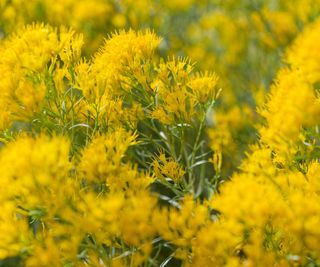
(Image credit: Mark C Stevens / Getty Images)
Rubber rabbitbrush (Ericameria nauseosa) is a shrub native to most of the western United States. It is related to sagebrush and is also called chamisa. You can find several subspecies but, generally, rubber rabbitbrush grows up to five feet (1.5m) tall. It has gray-green threadlike leaves and fall flowers to feed pollinators after many plants stop blooming. Its flowers are yellow, small, tubular and grow in clusters.
You can grow rubber rabbitbrush in USDA zones 4-9. As well as being one of the best native flowering shrubs that bees and butterflies will love, this plant tolerates dry soil, drought conditions (once established) and heavy winds. It needs a spot with full sun and can be used as a low hedge.
6. Common Buttonbush
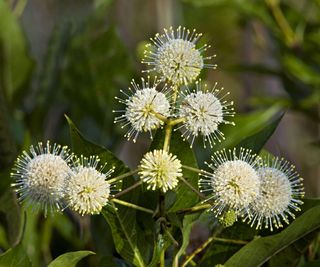
(Image credit: Ed Reschke / Getty Images)
Buttonbush (Cephalanthus occidentalis) is hardy in USDA zones 5-11 and is native throughout much of the eastern halves of the United States and Canada and also in the southwest. It was once used commercially by many beekeepers. Buttonbush is a great draw for pollinators and is notable for its round, golf ball-sized white flowers.
You can grow buttonbush up to eight feet (2.5m) tall and wide. It looks best when pruned, or else it can seem unkempt. It’s a good option for wet areas of the garden, as it grows naturally in marshes and bogs.
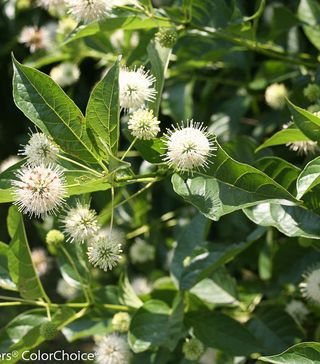
Cephalanthus Occidentalis ‘Sugar Shack’
If you’re after a compact shrub that appeals to bees, this shrubby beauty from Green Promise Farms is a delightful planting option. Glossy and fragrant, it’s great for bringing pollinators to modest spaces.
This article features products available from third-party vendors on the Gardening Know How Shop.


